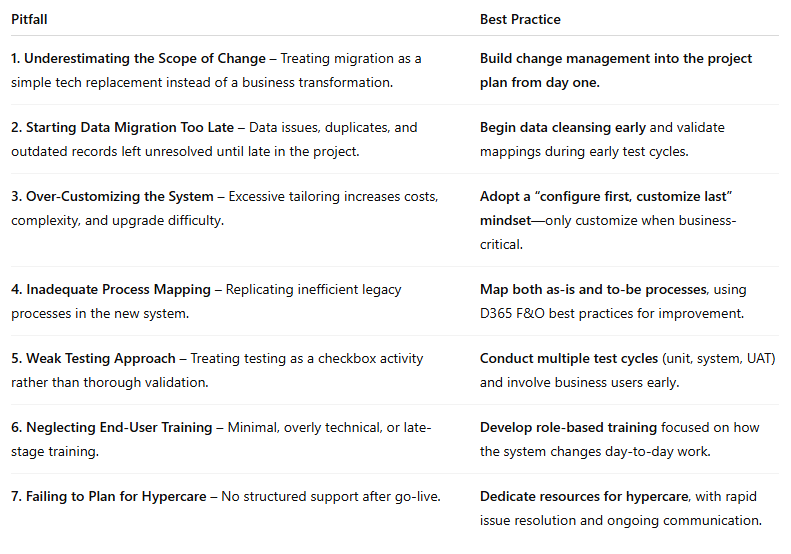Migrating from a legacy ERP to Microsoft Dynamics 365 Finance & Operations (D365 F&O) is one of the most impactful initiatives an organization can undertake. But it’s also one of the most complex—and the road is lined with potential pitfalls that can delay timelines, inflate budgets, and frustrate stakeholders.
Here are the seven most common traps to avoid, along with practical tips to keep your transformation on track.
Underestimating the Scope of Change
Too often, organizations treat the migration as a technology swap rather than a business transformation. D365 F&O changes workflows, reporting, and even decision-making processes. Ignoring this reality leads to resistance, confusion, and poor adoption.
Tip: Build change management into the project plan from day one.
Starting Data Migration Too Late
Data issues can derail the best-planned go-live. Legacy data often contains inconsistencies, duplicates, and outdated records. Leaving cleansing and mapping until late in the project forces rushed, error-prone work.
Tip: Begin data cleansing before the project officially starts and validate mappings during early test cycles.
Over-Customizing the System
While D365 F&O can be tailored extensively, excessive customization increases costs, complicates upgrades, and makes support harder.
Tip: Adopt a “configure first, customize last” mindset—stick to out-of-the-box functionality unless a customization is truly business-critical.

Inadequate Process Mapping
Many teams try to replicate old processes in the new system without assessing whether those processes still serve the business well.
Tip: Map both your as-is and to-be processes, leveraging D365 F&O best practices to improve efficiency and standardization.
Weak Testing Approach
Testing often becomes a checkbox exercise rather than a robust validation of processes, data, and integrations. This can lead to costly post-go-live issues.
Tip: Conduct multiple test cycles (unit, system, UAT) and involve business users early to ensure real-world scenarios are covered.
Neglecting End-User Training
Without proper training, even the best ERP system will fail to deliver value. Too often, training is rushed or overly technical.
Tip: Develop role-based training that focuses on how the system changes daily work, not just where to click.
Failing to Plan for Hypercare
Go-live is not the finish line—it’s the starting line for real-world use. Without a post-launch support structure, small issues can snowball into major disruptions.
Tip: Dedicate resources for a hypercare period, with rapid response to issues and continuous communication to users.
The following table is a side-by-side “Pitfall vs. Best Practice” quick reference.

Download Document, PDF, or Presentation
Author: Kimberly Wiethoff